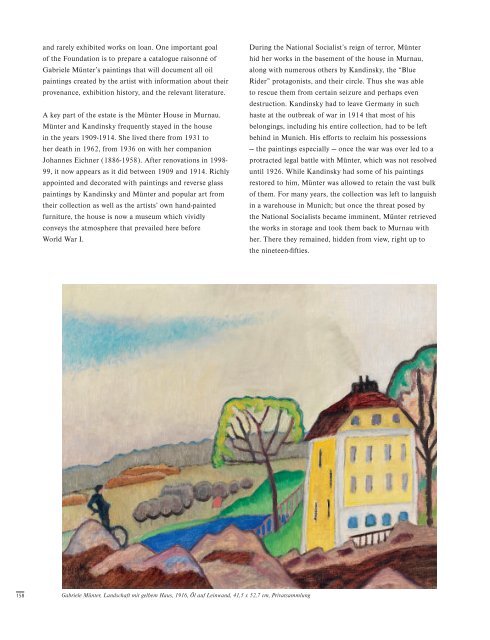You also want an ePaper? Increase the reach of your titles
YUMPU automatically turns print PDFs into web optimized ePapers that Google loves.
and rarely exhibited works on loan. One important goal<br />
of the Foundation is to prepare a catalogue raisonné of<br />
Gabriele Münter’s paintings that will document all oil<br />
paintings created by the artist with information about their<br />
provenance, exhibition history, and the relevant literature.<br />
A key part of the estate is the Münter House in Murnau.<br />
Münter and Kandinsky frequently stayed in the house<br />
in the years 1909-1914. She lived there from 1931 to<br />
her death in 1962, from 1936 on with her companion<br />
Johannes Eichner (1886-1958). After renovations in 1998-<br />
99, it now appears as it did between 1909 and 1914. Richly<br />
appointed and decorated with paintings and reverse glass<br />
paintings by Kandinsky and Münter and popular art from<br />
their collection as well as the artists’ own hand-painted<br />
furniture, the house is now a museum which vividly<br />
conveys the atmosphere that prevailed here before<br />
<strong>World</strong> War I.<br />
During the National Socialist’s reign of terror, Münter<br />
hid her works in the basement of the house in Murnau,<br />
along with numerous others by Kandinsky, the “Blue<br />
Rider” protagonists, and their circle. Thus she was able<br />
to rescue them from certain seizure and perhaps even<br />
destruction. Kandinsky had to leave Germany in such<br />
haste at the outbreak of war in 1914 that most of his<br />
belongings, including his entire collection, had to be left<br />
behind in Munich. His efforts to reclaim his possessions<br />
— the paintings especially — once the war was over led to a<br />
protracted legal battle with Münter, which was not resolved<br />
until 1926. While Kandinsky had some of his paintings<br />
restored to him, Münter was allowed to retain the vast bulk<br />
of them. For many years, the collection was left to languish<br />
in a warehouse in Munich; but once the threat posed by<br />
the National Socialists became imminent, Münter retrieved<br />
the works in storage and took them back to Murnau with<br />
her. There they remained, hidden from view, right up to<br />
the nineteen-fifties.<br />
158<br />
Gabriele Münter, Landschaft mit gelbem Haus, 1916, Öl auf Leinwand, 41,5 x 52,7 cm, Privatsammlung


















